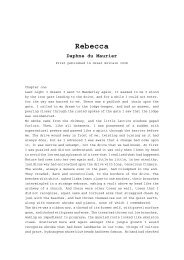Brand Failures
Brand Failures
Brand Failures
Create successful ePaper yourself
Turn your PDF publications into a flip-book with our unique Google optimized e-Paper software.
Internet and new technology failures 251<br />
through the use of Flash. However, many Internet users did not have a Web<br />
browser that could support this technology. Furthermore, in 1999 most PCs<br />
had a 56k (or slower) modem. This meant that the graphics-intensive site,<br />
which, as well as the attraction of Miss Boo offered visitors the chance to<br />
‘rotate’ items before making a purchase, was going to be somewhat slow. How<br />
slow Well, on an average computer the home page could take around three<br />
minutes to load and that was after having to sit through a lengthy animated<br />
introduction. Oh, and if you had a Mac you couldn’t access the site at all.<br />
Small wonder that the leading Internet usability experts, such as the highprofile<br />
author and Web engineer Jakob Nielsen, quickly pounced on boo.<br />
com as the archetypal example of how not to build a Web site. When he first<br />
reviewed the site for his Alertbox newsletter in December 1999, Nielsen<br />
could hardly believe what he saw:<br />
Instead of making it easy to shop, the site insists on getting in your face<br />
with a clumsy interface. It’s as if the site is more intent on making you<br />
notice the design than on selling products. Furthermore, it is simply<br />
slow and unpleasant. All product information is squeezed into a tiny<br />
window, with only about one square inch allocated to the product<br />
description. Since most products require more text than would fit in<br />
this hole, boo requires the user to use a set of non-standard scroll<br />
widgets to expose the rest of the text. Getting to a product requires<br />
precise manipulation of hierarchical menus followed by pointing to<br />
minuscule icons and horizontal scrolling. Not nice.<br />
Not nice indeed. But then, Alertbox was only distributed to ‘techies’, not the<br />
highly fashion-conscious affluent consumers boo wanted to reach. So why<br />
worry too much when they had already managed to secure complementary<br />
articles in the UK and US editions of Vogue, alongside various newspapers<br />
Ironically, the company founders’ undeniable talent for publicity was<br />
starting to turn against them. Having spent millions on advertising and<br />
having generated thousands of column inches in the press, expectations had<br />
been inevitably high. While the company succeeded in creating a young and<br />
hip image (in 1999 Fortune magazine picked it as one of its ‘Cool Companies’<br />
of the year) it had also placed itself under too bright a spotlight. Alongside<br />
attacks in the Internet media regarding the site’s functionality – or rather, lack<br />
of functionality – the mainstream press was also starting to pick up on the










